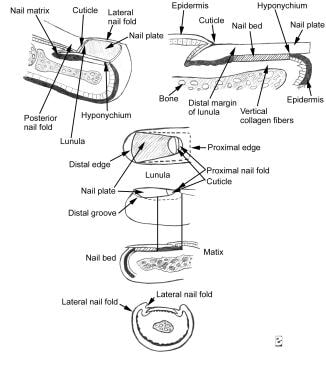Blood supply
An abundantly rich arterial and capillary vascular network supplies the nail unit. The ulnar and posterior tibial arteries divide into the proper palmar and plantar digital arteries, respectively. The two digital arteries, which occupy the lateral and medial aspects of the digit, form a cruciate anastomosis at the level of the deep dermis in the ventral pulp space. Upon anastomosing on the volar aspect of the terminal phalanx, the two arteries contribute branches to a superficial arcade and the underlying phalangeal periosteum. The superficial arterial arcade, which also receives a contribution from a vessel coursing dorsally over the DIP joint, supplies the PNF, including the capillary loops of the nail fold and the nail matrix.
The digital arteries continue around the waist of the terminal phalanx and onto the dorsal surface where they divide near the DIP joint to form the dorsal and ventral arches supplying the nail bed and the nail matrix. The dorsal arch courses dorsally over the DIP joint where it terminates in an anastomosis with the proximal arch to supply the matrix and the PNF. The capillary loop system in the PNF is derived from the anastomosis between the two arches. Therefore, perfusion of the nail matrix comes from two arterial systems: the superficial arcade and the proximal arcade. Anatomically, the superficial arcade sits at the base of the PNF, while the proximal arcade lies deep to the matrix. The ventral or distal branch supplies the remainder of the nail unit, specifically its most distal aspect, including the fingertips.
An accessory blood supply that is separate from the main blood supply in the pulp space also exists. This accessory system is important in providing adequate perfusion of the nail unit for normal nail growth when the primary vasculature is compromised by disease, which sometimes occurs in scleroderma or infection.
Specialized neurovascular structures called glomus bodies are widely distributed throughout the arterial and deep venous circulation. These oval bodies are encapsulated, consisting of tortuous blood vessels and a neural supply of mostly cholinergic nerves. The glomus bodies form an extensive arteriovenous (AV) anastomotic network, which functions in modulating the thermoregulatory response of the nail unit. Under circumstances where the nail is exposed to cold temperatures, the glomus bodies enhance blood flow to the nail complex by dilating and shunting blood through their complex AV anastomotic systems to prevent ischemia.
The nail apparatus is also richly innervated by a complex neural system allowing tactile sensitivity and sensory discrimination. Anatomically, the laterally positioned digital nerves and their divisions nearly parallel the vascular supply to the nail unit.



0 Comments:
Post a Comment